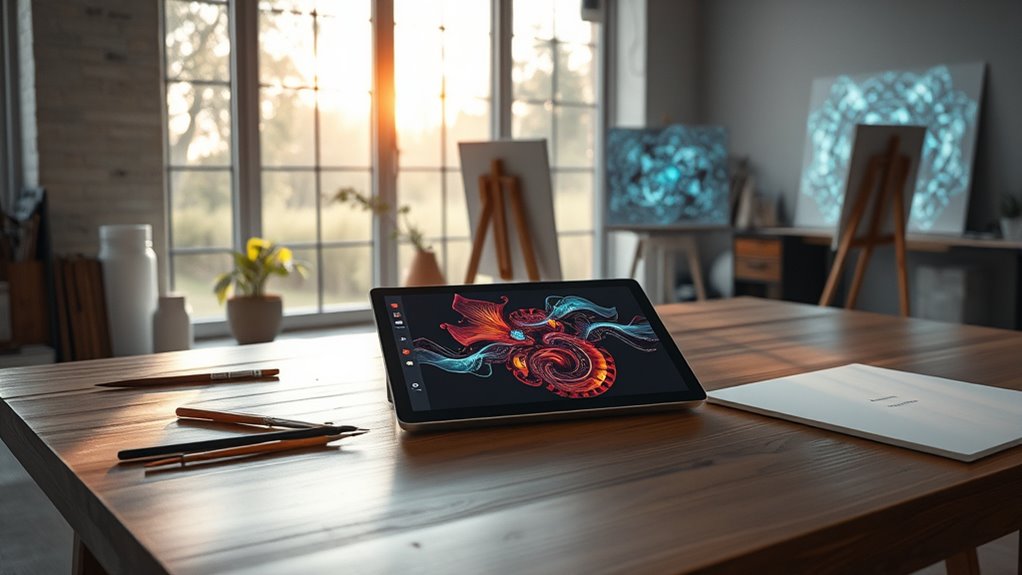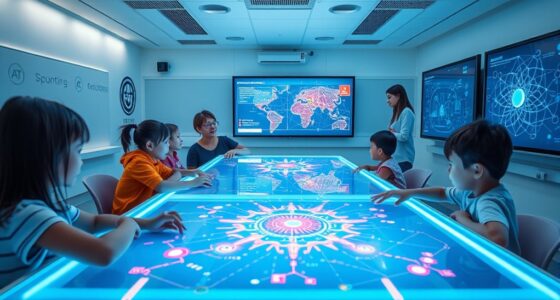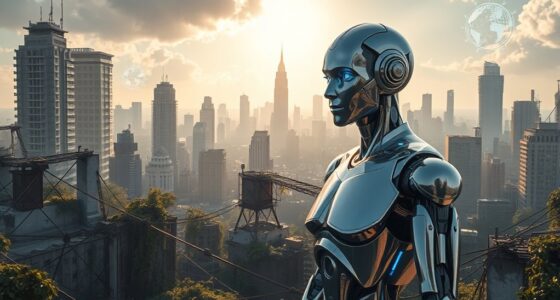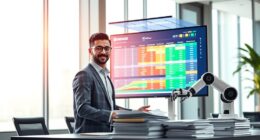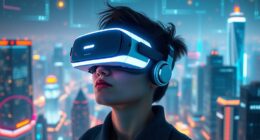You don’t need to fear AI; instead, see it as an opportunity to boost your creativity and expand your skills. AI tools can handle routine tasks, freeing you to focus on innovation and unique ideas. While some jobs may change, new roles like AI art curators are emerging. Staying adaptable and learning new skills guarantees you remain relevant. If you keep exploring, you’ll discover how to thrive alongside AI in your creative career.
Key Takeaways
- AI enhances creativity and productivity, enabling designers and artists to focus on innovation rather than routine tasks.
- New roles like AI art curators and ethics specialists offer additional career opportunities in the evolving industry.
- Developing skills in AI programming and data analysis can help creatives stay competitive and adapt to technological changes.
- While automation may displace some jobs, AI also democratizes access to resources, fostering growth and new business models.
- Focusing on uniquely human traits like emotional intelligence and original thinking ensures sustained relevance despite AI advancements.
The Evolving Landscape of Creative Professions With AI
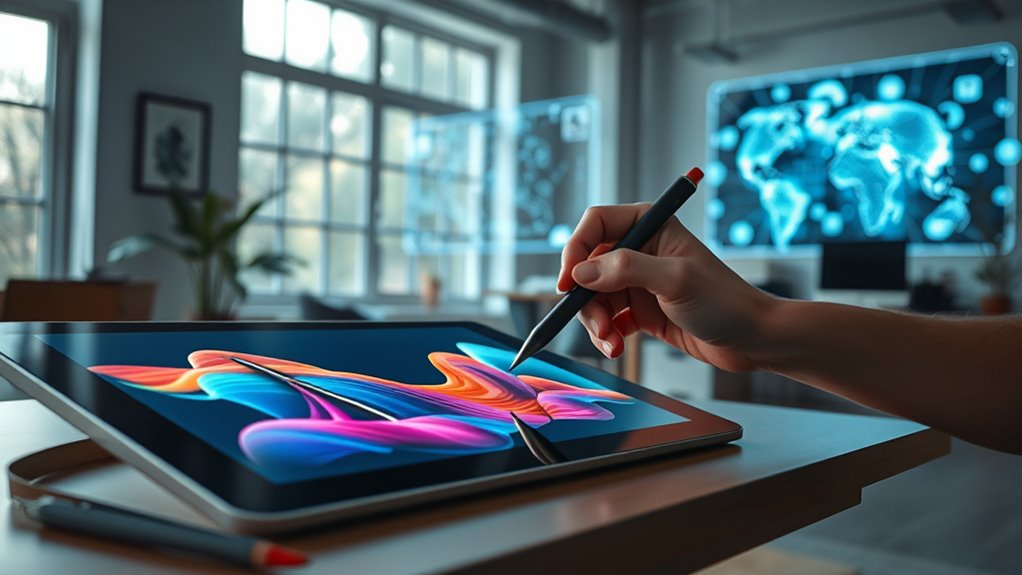
The landscape of creative professions is rapidly transforming as AI becomes an integral part of workflows. You’ll find that 83% of creative professionals now use generative AI, boosting their creative abilities by an average of 26%. Intuitive AI tools are breaking down technical barriers, making advanced creative resources accessible to more people. This democratization is reshaping industries like graphic design and content creation, pushing boundaries and opening new creative horizons. With AI handling routine tasks, you can focus more on innovative ideas and complex projects. Additionally, understanding sound healing science and how it influences well-being can inspire new multimedia and experiential art forms. Exploring creative workflows can help professionals adapt to these technological shifts more effectively. For example, tuning your vehicle’s performance can serve as a metaphor for optimizing your creative process, highlighting the importance of adjustments and upgrades in achieving peak results. Recognizing the importance of mental health in maintaining creativity is also crucial as the industry evolves. As AI continues to evolve, staying informed about technological advancements can empower professionals to leverage new tools effectively. However, this shift isn’t just about enhancement; it’s fundamentally changing how work is done. As AI integrates deeper into your field, staying adaptable becomes essential to harness its full potential and remain competitive in this evolving landscape.
Opportunities Emerging From AI Integration in Design and Art
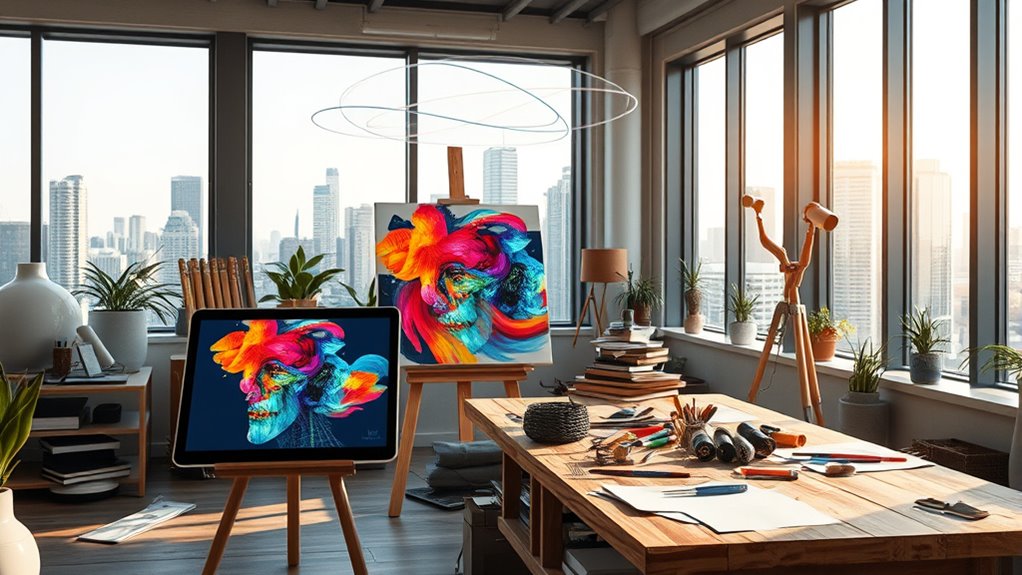
As AI becomes more integrated into design and art, new creative roles are emerging, giving you opportunities to innovate and redefine your craft. You’ll find that collaboration between humans and AI enhances artistic possibilities while streamlining workflows. This integration also offers significant cost savings and productivity gains, allowing you to focus more on your creative vision. This shift is supported by the growing availability of generative AI tools, which can help generate novel ideas and assist in visualizing concepts rapidly, opening up new avenues for artistic exploration. Additionally, understanding emotional support can help artists and designers manage the stresses associated with technological change and stay resilient in evolving creative fields. Incorporating remote hackathons as collaborative platforms can further foster innovation and community engagement among creative professionals. Embracing mental well-being techniques can further aid in navigating these transitions effectively. Moreover, being aware of asset division strategies can help artists and creative entrepreneurs protect their work and financial interests amid these industry shifts.
New Creative Roles Emerge
AI is reshaping creative industries by giving rise to new roles and opportunities that didn’t exist before. You’ll find yourself exploring expanded creative possibilities, pushing boundaries with AI as your partner. As AI integrates into workflows, some traditional jobs may shift, but new specializations emerge—like AI art curators or ethics specialists—requiring fresh skills. Nearly half of artists believe AI enhances their work, serving as a tool for innovation. This opens doors to novel business models, such as AI-generated content services, and boosts productivity by up to 26%. You’ll need to develop skills in AI programming and data analysis to stay ahead. Overall, AI is redefining what it means to be a creator, offering exciting opportunities to innovate and grow in ways previously unimaginable.
Enhanced Artistic Collaboration
Innovative collaboration tools powered by AI are transforming how artists and designers work together, offering real-time feedback and creative suggestions that elevate the process. These tools enable you to explore new styles and push creative boundaries more efficiently. As AI becomes more accessible, up to 60% of creative firms are integrating generative solutions into their workflows. This surge fuels market growth, projected to reach $5 billion by 2025, and sparks artistic innovation. AI-driven collaboration encourages experimentation and broadens participation. Incorporating home decor elements into design workflows can also inspire unique aesthetic choices and elevate creative projects. Additionally, understanding retail hours can help artists and designers plan their visits to suppliers or stores more effectively. Recognizing the importance of emotional connection in art creation can further enhance the impact of collaborative efforts. Moreover, leveraging insights from health benefits can contribute to better mental well-being and sustained creativity during intensive projects. Furthermore, being aware of cookie categories helps users better understand how their data is managed during collaborative processes.
Cost and Productivity Gains
Integrating generative AI into design and art workflows unlocks significant cost savings and productivity improvements. You can optimize designs for manufacturing, reducing logistics and production costs. AI tools boost your throughput by an average of 66%, enabling you to accomplish more in less time. Automation handles routine tasks, freeing you to focus on higher-value activities. It also helps select materials more efficiently, cutting design expenses. Workers using AI report saving about 5.4% of their work hours, translating to increased productivity. On a broader scale, AI can raise sales productivity by 3-5%, with potential billions in added value across industries. As adoption grows—from 33% in 2023 to 71% in 2024—AI’s ability to create new product categories promises significant economic growth and job transformation, augmenting your capabilities rather than replacing your role. Generative AI models can process large datasets and generate diverse content, further expanding creative possibilities and operational efficiencies. Moreover, the integration of holistic approaches ensures that these technological advancements support sustainable and emotionally intelligent design practices. Additionally, understanding the trustworthiness of AI tools is crucial for responsible implementation and maintaining client confidence. Recognizing the importance of privacy and cookie management helps safeguard user data and promotes ethical AI use, fostering trust in creative industries. Also, considering safety features in AI-driven tools can enhance reliability and reduce potential risks associated with automation.
Skills and Education for Thriving in an AI-Driven Creative World
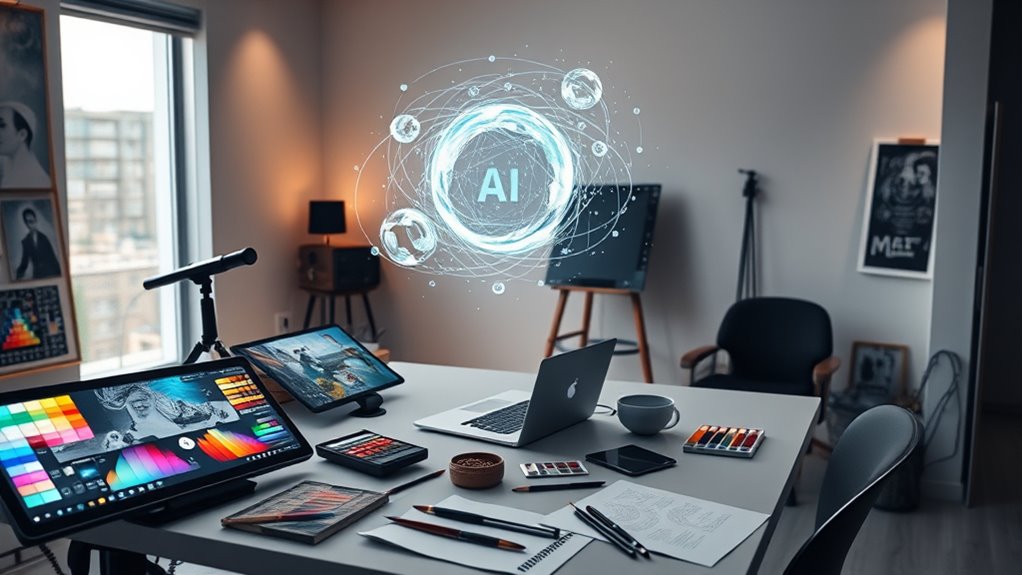
To thrive in an AI-driven creative world, you need to develop a diverse set of skills and pursue targeted education that keeps pace with technological advancements. Technical literacy is essential; understanding programming languages helps you integrate AI tools into your work. Data analysis skills enable you to interpret AI-generated insights for better decision-making. Critical thinking allows you to evaluate AI outputs and guarantee they align with your creative goals. Familiarity with collaboration platforms enhances human-AI teamwork, boosting productivity. Ethical awareness is indispensable to navigate issues like privacy and fairness. You should pursue online courses and hands-on projects to build practical experience. Engaging in communities, combining AI with traditional skills, and embracing AI ethics training prepare you to adapt and innovate in this evolving landscape. Additionally, understanding Ethical Hacking principles can help you identify potential security risks associated with AI tools and ensure responsible usage. Developing a Self-Understanding of your personal strengths and weaknesses can further enhance your ability to adapt creatively. Gaining knowledge of Human-AI Collaboration strategies can also improve your ability to work effectively alongside emerging technologies. Moreover, staying informed about Merchant Services and their evolving security standards can help you safeguard your creative assets in digital transactions. Recognizing the importance of Eye Patch Benefits and related skincare knowledge can also be beneficial when preparing for video calls or in-person meetings to maintain a professional appearance.
Challenges and Risks for Creative Workers in the Age of Automation
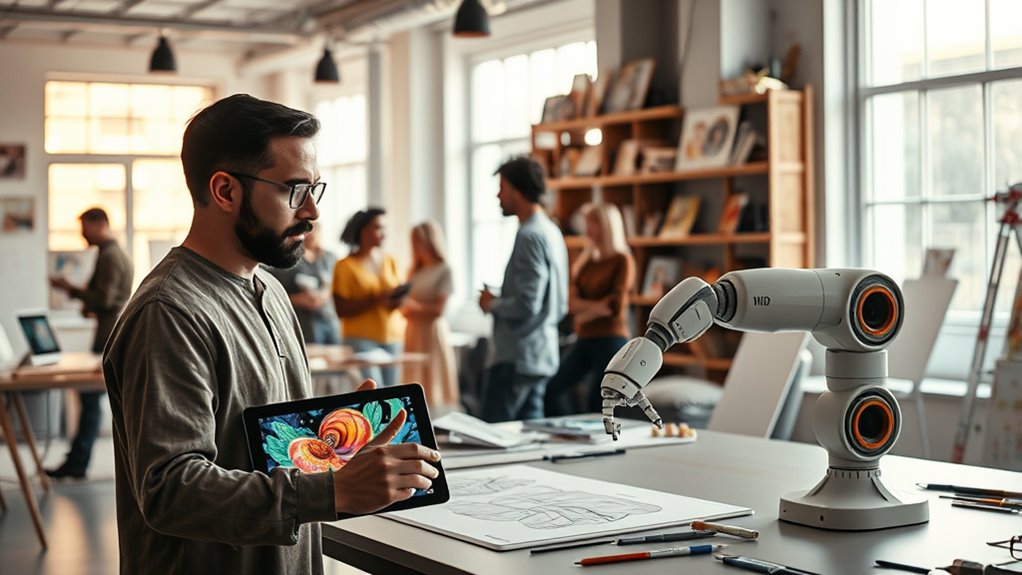
As AI becomes more capable of automating creative tasks, it introduces significant challenges and risks for workers in the industry. Job security is at stake, with up to 9.1% of jobs worldwide potentially replaced, especially in writing and photography. Automation trends show 40% of employers planning workforce reductions where AI can do the work. Generative AI may lead to 5%+ job cuts for a quarter of CEOs in 2024, displacing nearly 50 million US jobs. Opportunities shrink as entry barriers rise, salaries drop, and global competition intensifies. Here’s a snapshot:
| Challenge | Impact | Example |
|---|---|---|
| Job Loss | Displacement of creative roles | Photography, writing |
| Reduced Opportunities | Fewer paths for newcomers | Entry-level barriers |
| Economic Pressure | Lower wages, social mobility issues | Salary pressures |
| Ethical Concerns | Ownership and authorship questions | AI-generated content |
Furthermore, the increasing reliance on AI tools may alter creative workflows and redefine industry standards, making adaptability essential for artists and designers. The shift towards automation could also influence industry ethics, raising questions about originality and intellectual property rights in AI-generated works.
Global Trends and Regional Variations in AI Adoption for Creatives
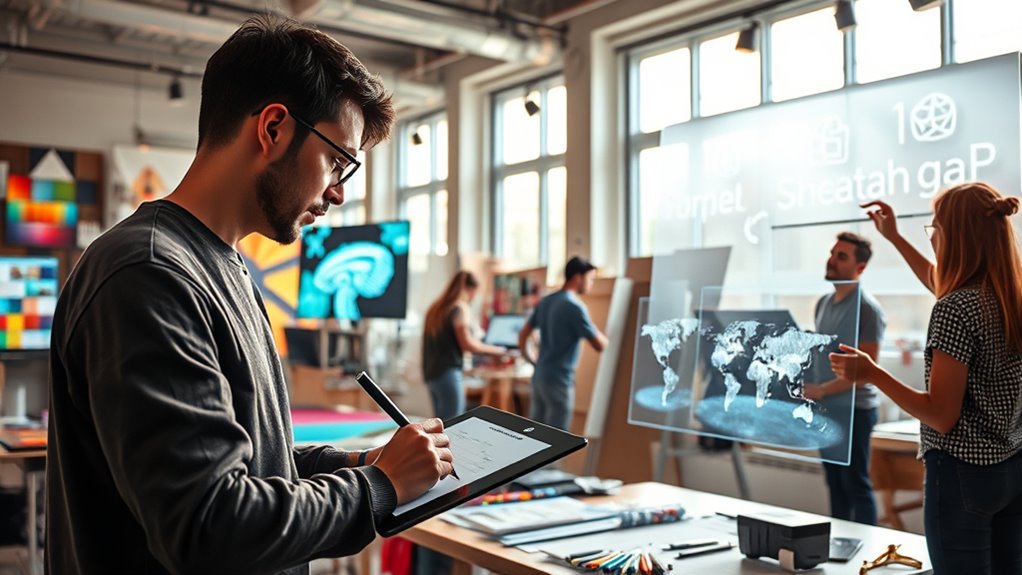
You’ll notice that AI adoption varies widely across regions, driven by differences in infrastructure and cultural attitudes. In North America and Asia-Pacific, robust tech ecosystems fuel faster integration into creative fields, while other areas face hurdles. Policy differences also shape how quickly and freely creatives can leverage AI tools worldwide.
Regional AI Adoption Rates
Regional variations markedly influence how quickly and extensively AI tools are adopted by creative professionals worldwide. In the United States, about 87% of creatives use AI tools, making it one of the highest adoption rates. North America and Western Europe lead in marketing and advertising, with around 75% actively testing or using AI. Meanwhile, Asia-Pacific shows rapid growth, with adoption rates between 70% and 80%. Emerging markets in Latin America and Africa have lower current adoption but are expected to grow fast. Factors like infrastructure, investment, and regulations impact these differences.
Key points include:
- North America and Western Europe lead in AI tool usage.
- Asia-Pacific shows rapid adoption but slightly lower rates.
- Latin America and Africa are emerging markets with potential.
Industry-Specific Variations
Industry-specific adoption of AI tools varies widely across the globe, driven by differing technological capabilities, investment levels, and cultural influences. In some regions, substantial funding and advanced infrastructure accelerate AI integration into creative sectors like film, art, and design, fueling market growth. For example, the AI creative market is projected to reach $80 billion by 2025, with sectors like AI video creation expected to hit $2.56 billion by 2032. Cultural factors shape local innovations, resulting in diverse expressions of AI-generated art reflecting regional identities. While AI enhances productivity and opens new opportunities, acceptance levels differ, influencing how quickly industries adopt these tools. Overall, these industry-specific dynamics shape how AI reshapes creative landscapes worldwide, highlighting both opportunities and challenges unique to each region.
Global Policy Differences
How do global policy differences influence the adoption of AI in creative industries? They shape how quickly and ethically AI integrates into your work. Countries vary in their approach to copyright, fair use, and ethical standards, affecting content creation and ownership. For example, some regions promote open licensing, encouraging collaboration, while others enforce strict data laws that limit AI development. International cooperation is essential to create consistent rules, but disparities remain. Consider these key points:
- Copyright and Fair Use: Varying interpretations impact AI-generated content rights.
- Ethical Standards: Different standards influence AI’s role in supporting or replacing creativity.
- Marketplace Licensing: Regulations shape content-sharing and AI innovation globally.
Understanding these differences helps you navigate evolving regulations and leverage AI effectively across borders.
Preparing for the Future: Strategies for Creatives to Stay Relevant
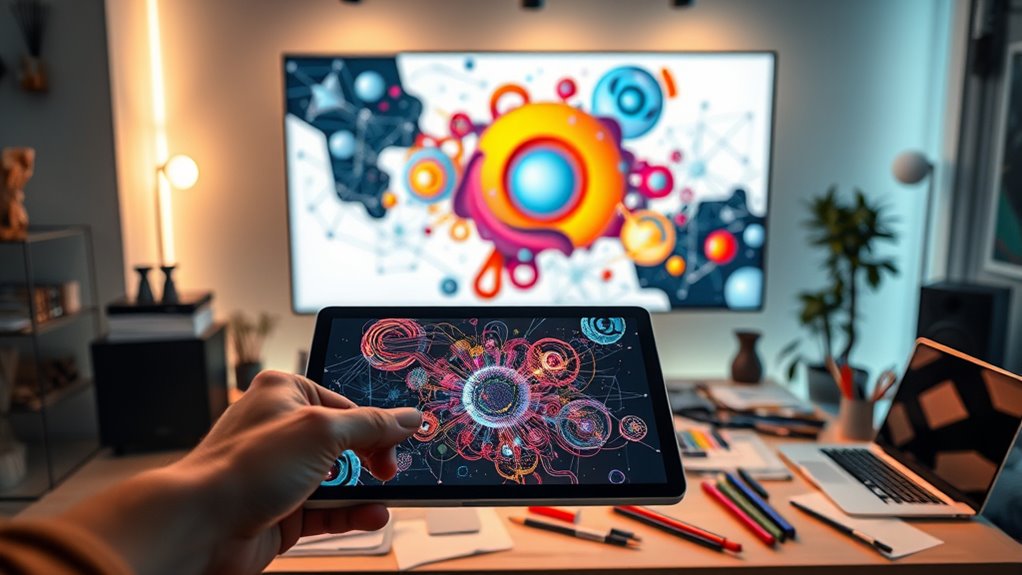
As AI continues to transform the creative landscape, staying relevant requires proactive strategies. You need to upskill and reskill, learning how to work alongside AI tools to enhance your capabilities. Integrating AI into your workflow can boost productivity and help you adapt to changing demands. Focus on tasks that leverage your uniquely human traits, like emotional intelligence and original thinking, which AI can’t replicate. Entrepreneurship and innovation are also vital—develop new business models that harness AI’s potential. Keep yourself updated with the latest AI trends and technologies through continuous learning. By doing so, you’ll position yourself for long-term career stability, remain competitive, and turn AI from a threat into an opportunity for growth and creative evolution.
Frequently Asked Questions
How Quickly Will AI Replace Human Creativity in Design and Art?
You wonder how fast AI might replace human creativity in design and art. While AI generates millions of images daily and automates routine tasks, it still lacks the emotional depth, originality, and nuanced problem-solving only humans provide. Instead of replacing you, AI will likely transform your role, making you focus more on strategic and conceptual work. By embracing AI as a collaborative tool, you can stay relevant and even enhance your creative output.
Can AI Tools Enhance Rather Than Threaten Creative Careers?
Think of AI tools as a paintbrush in your hand, not a replacement for your artistic vision. They enhance your skills by speeding up drafts, exploring ideas, and automating repetitive tasks. Instead of threatening your career, AI acts as a creative partner, expanding your possibilities. By mastering these tools, you can craft more innovative work, stay competitive, and focus on the human touch that truly makes your art unique.
What Ethical Concerns Arise From Ai-Generated Art and Design?
You should consider the ethical concerns surrounding AI-generated art, like copyright infringement, deception, and bias. AI can replicate protected work without proper credit, potentially harming original artists. It can also spread misinformation if mistaken for real images, and reflect societal biases, perpetuating stereotypes. Plus, the environmental impact of energy-intensive AI tools raises sustainability issues. These concerns highlight the need for responsible use and regulation of AI in creative fields.
How Will AI Influence Copyright and Intellectual Property Laws?
You might find it surprising that 70% of countries are updating IP laws to address AI’s impact. AI influences copyright by challenging traditional notions of authorship, since current laws require human input. As a creator, you should stay informed about evolving regulations, as transparency and respecting intellectual property rights become more critical. While AI can generate works, legal systems aim to protect human creativity, emphasizing your role in ownership and originality.
Will AI Create More Jobs Than It Displaces in the Creative Industry?
You might wonder if AI will generate more jobs than it displaces in the creative industry. While AI can automate routine tasks, it also creates new roles like AI trainers and content curators. You’ll need to adapt by developing new skills, focusing on AI-assisted work. Ultimately, AI’s impact depends on how quickly you embrace change and leverage these emerging opportunities to stay relevant and thrive in the evolving landscape.
Conclusion
As AI continues to weave into your creative world like a rising tide, you have the power to navigate its currents. Embrace new tools as your brushes and palettes, shaping vibrant works from shifting landscapes. Stay curious, hone your skills, and adapt with resilience. In this evolving digital canvas, your unique human touch will remain your greatest masterpiece—ensuring you thrive amid the AI horizon rather than fear it.
